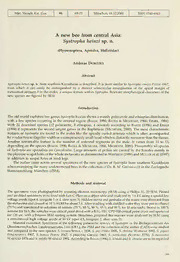
A new bee from central Asia: Systropha heinzi sp. n. (Hymenoptera, Apoidea, Halictidae) PDF
Preview A new bee from central Asia: Systropha heinzi sp. n. (Hymenoptera, Apoidea, Halictidae)
Mitt. Münch. Ent.Ges. asSynonyms,furthermoreS.lürsutasensuWarncke(1976,1980)andsensuPonomareva(1967)istobeconsidered as S. pici. Followingabbreviationsareusedthroughoutthetext: AS: antennalsegment; BL:bodylength; FWL: length of forewing; GS: gonostylus; L/W: length/width quotient of antennal segment; S: metasomal sternum; T:metasomal tergum. The degree of cuticular surface punctation is measured by the distance between Single depressions relative to theirdiameters. Thus punctation is considered sparse/dense when the distancebetween the depressions is as wide as, or greater/less than the diameterofa single depression. Usage ofmorphological terminology follows Michener (2000). Systropha heinzi sp. n. Type material: Holotype: S, southern Kazakhstan, Turkestan, 24.V.1998, leg. S. Ovtschinnikov, ex coli. GrÜn- WALDT (ZSM). Paratypes: 2\S, 19, same data as holotype (ZSM, CAD). Description Male. BL: 9.5-12.8 mm. FWL: 7-8.6 mm. Structure: Head slightly broader (1.2 times) than long in frontal view. Galea weakly shiny with minute dense punctation. Labrum smooth and shiny, without distinct punctation. Clypeus with coarse irregulär honeycomb punctation, dull (basally) to shiny (apically). Other parts ofhead smooth to weakly tesselate, shinywithdensepunctation(<1). GenalareaaboutaswideasCompoundeyeinlateralview.Hindmargin ofVertexbroadly rounded. Distancebetweenhind marginoflateralocellustohindmarginofvertexabout 2.2 times as wide as diameter of lateral ocellus. Scape smooth and shiny with minute, dense punctation, about2.3timeslongerthanbroad.AS3about3.6timesaslongasbroad,0.8timesaslongasfollowingtwo AS together. LengthAS4:5:6:7:8:9:10:11:12:13 = 1.0:1.1:1.2:1.2:1.4:1.7:1.6:1.5:1.3:1.1. L/Wratiosof AS4-13: 1.8; 1.7; 1.5; 1.4; 1.6; 2.7;3.0;4.3;4.7; 6.0. Scutumsmoothand shinywithdistinctdensepunctation becoming increasing less dense from anterior to posterior margin. Scutellum smooth and shiny with irregulär punctation, which is particularly scattered on lateral humps. Metanotum, dull, finely wrinkled. Propodealtrianglefinelywrinkledallover,exceptsmoothand shinyareaalonghindmargin.Lateralparts ofdorsalpropodeumwithadenseandweaklyhoneycombpunctationthereforedulltoweaklyshiny.Tl-6 weakly tesselate with strong and dense punctation (<1) on disc and weak, dispersed punctation (>2) on marginal zone. Dorsolateral convexity of Tl-6 strongly developed. Marginal zone ofTl-2 about as long as disc, distinctly longer than disc on T3-6. T7 dull with with irregulär punctation ranging from coarse (basally)tominute (apically). Apical marginofT7straighttoweaklyrounded. S2and3withcone-shaped paired projectionsdistinctlylargeronS2thanonS3(Figs7, 8). S6withweakmediancarinaonapicalhalf. Apical marginofS6with medianemargination, witha distinct tooth-likeprojectionin themiddle (Fig. 7). ShapeofS7asshowninFig.3. DorsaloutlineofapicalpartofS8slightlyangled (Fig.4) to well-rounded (Fig. 5). This Variation is caused by a dorsolateral lamella which is more or less prominently developed. Of the 22 males 20 show a more or less angled outline (similar to Fig. 4) while only two males show the strict well-rounded condition as in Fig. 5. Ventral SS strongly flattened (Fig. 6). Apical marginofS8 with distinct semicircular emargination in the middle (Figs 4-6). Male genitalia as in Figs 1 and 2. Integumentalcolor: Blackexceptthefollowingstructures:VentralsideofAS4withanapicalyellowish brown spot. AS5-8 yellowish orange beneath, AS9-13 bright brown. Stigma of front wings with a bright yellowish transparency. Distal tarsal Segments (2-5) brown. Claws brown basally, darkly reddened apically. All leg spurs with a yellowish gray transparency. Marginal zone of T with a dark brownish transparency. Pubescence: Wead and thorax with silvery white hairs conspicuously long on lower part of frons, Vertex, genal area and dorsal partsofthorax (scutum, scutellum and metanotum). Legswith silvery white hairsofvaryinglength. Labrumapicallywithshortyellowishgraypubescence, formingdistincthairfringe alongapicalmargin. PubescenceofTl-7silverywhitewithlonghairsbasally, and mediumlongdispersed hairs on marginal zone. S with sparse whitishpubescence ofextremely short (disc) to medium long hairs (laterally). Female. BL: 9.7mm. FWL: 7.0 mm. Structure: Shape and structure of head similar to male except the following: Scape more slender than in male,3timesaslongasbroad.AS3short,slightlylongerthanfollowingtwoAStogether.AS4-11 dishnctly 70 Figs1-6. Genitalia(1,2),S7(3)andS8(4-6)ofSystrophaheinzisp.n.(male); 1,3-5,dorsalview; 2,6,ventralview. Scalebars: 250|im. W broader than long, AS13 nearly as long asbroad, L/ ratios ofAS4-12: 0.8; 0.5; 0.6; 0.6; 0.5; 0.5; 0.6; 0.5; 0.9. LengthAS4:5:6:7:8:9:10:11:12= 1.0:0.8:1.1:1.1:1.3:1.3:1.4:1.3:2.3. Thoraxsimilarto male. Discof Tl-5 with punctation similar to that in male, but more strongly tesselate. Marginal zone of Tl-4 more stronglytesselatethaninmalewithinconspicuouslyweakandscatteredpunctation.MarginalzoneofTl-3 distinctly shorter (0.7 hmes) than disc, about as long as disc on T4 and 5. Dorsolateral convexity ofTl-4 well-developed but less so in male. Pygidial plate crenulate, dull, about as broad as ASS. Sl-6 strongly tesselatewithindistinctwrinkle-likepunctation.ApicalmarginofS2-4straight, ofS5broadlyconcave. S6 triangulär. Integumental color: Black except the following structures: Ventral side of AS4 and 5 dark brown, AS6-12 bright brown beneath. Stigma of front wings with a bright yellowish transparency. Distal tarsal Segments (2-5) dark brown. Claws yellowish brown basally, darkly reddened apically. Spurs of all legs with a yellowish gray transparency. Marginal zone of T bright with a yellowish brown transparency. Pubescence: Head and thorax with similar pubescence as in male but distinctly shorter, especially on frons,Vertexanddorsalpartsofthorax. Legswithsilverywhitetoyellowishwhitehairsofvaryinglength. PubescenceofTl-4yellowishwhitetograyishwhiteofshorttomediumlong hairswhicharerathersparse 71 7 References Baker, D.B. 1996: Notesonsomepalearcticandoriental Systropha, withdescriptionsofnewspeciesandakeyto the species (Hymenoptera: Apoidea: Halictidae) -J. Nat. Hist., 30, 1527-1547. Batra, W. T. & C. D. MiCHENER 1966: The nest and description of a new bee, Systropha punjabensis from India (Hymenoptera: Halictidae). -J. Kans. Entomol. Soc, 39, 650-658. Ebmer, A. W. 1994: Si/strof>hadijfonnis Smith 1879 und Systropha inexspcctata n. sp., diebeidenöstlichenVertreter der altweltlichen Gattung Systropha Illiger 1806 (Insecta: Hymenoptera: Apoidea: Halictidae: Rhophitinae). - Linzerbiol. Beitr., 26, 807-821. MiCHENER, C. D. 2000: The bees of the world. Baltimore and London -Johns Hopkins University Press. Müller, A., A. Krebs & F. Amiet 1997: Bienen. Mitteleuropäische Gattungen, Lebensweise, Beobachtung. - Naturbuch Verlag, Augsburg. PONOMAREVA, A. 1967: Notes sur les especes palearctiques du genre Systroplia III. (Hymenoptera, Apoidea; Halictidae). - Pol. Pismo Entomol., 37, 677-698. Warncke, K. 1976: Beitrag zur Bienenfauna des Iran. 2. Die Gattung Systroplia III. - Boll. Mus. Civ. Stör. Nat. Venezia, 28, 93-97. Warncke, K. 1980: DieBienengattungenNomiaund Systropha imIranmit Ergänzungenzu denNomia-Artender Westpaläarktis. - Linzerbiol. Beitr., 12, 363-384. Westrich, P. 1989: Die Wildbienen Baden-Württembergs, 2 Bände, 2. Aufl. - Ulmer Verlag, Stuttgart. Author's address: Andreas Dubitzky ZoologischeStaatssammlung München Münchhausenstr. 21 D-81247 München, Germany E-mail: [email protected] 73
